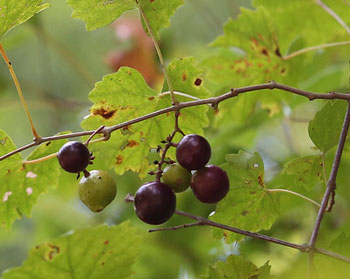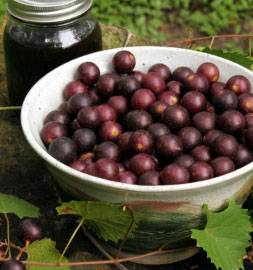Tips and Tricks for Making Muscadine Jelly
 Instructions on how to make the perfect Muscadine Jelly.
Instructions on how to make the perfect Muscadine Jelly.
Muscadine grapes are at their peak and many people are preserving their wonderful
flavor by making homemade jelly. I must confess, this is a repeat article, but I still
have lots of interest from consumers about making this fall favorite jelly.
Here are some tips and tricks to help your jelly, no matter what kind, have the consistency you desire.
For the proper texture, you must have the correct combination of fruit, pectin, acid and sugar. Start by picking your muscadines at the right time. They should be ripe, but not overripe. Overripe fruits tend to have less pectin. Pectin is a substance in fruits that form a gel if they are in the right combination with acid and sugar. All fruits contain some pectin, but at different levels. Since fully ripe fruit has less pectin, one-fourth of the fruit used in making jellies should be under-ripe.
 In order to get a good gel on your jelly, you must also have the proper level of acid.
If there is too little acid, the gel will never set; if there is too much acid, the
gel will lose liquid (weep). For fruits low in acid, adding a little lemon juice will
help solve the problem. One or two tablespoons should do the trick. This may be more
important if you are making jelly without a commercial pectin product.
In order to get a good gel on your jelly, you must also have the proper level of acid.
If there is too little acid, the gel will never set; if there is too much acid, the
gel will lose liquid (weep). For fruits low in acid, adding a little lemon juice will
help solve the problem. One or two tablespoons should do the trick. This may be more
important if you are making jelly without a commercial pectin product.
Sugar not only aids in the flavor of homemade jellies, but it also helps in gelling and helps to prevent spoilage. If you are concerned about the amount of sugar in your diet and want to cut back, you should only use a recipe that is tried and true.
Do not try reducing the amount of sugar in a traditional recipe. It will not work and may cause spoilage of the product. There are some commercial pectins available that use reduced amounts of sugar. These should be used if trying to cut back on sugar.
How to make the perfect jams or jellies.
There are basically two methods of making jams and jellies.
- The standard method, which does not require added pectin, works best with fruits that are naturally high in pectin. These fruits include apples, crabapples, gooseberries and some plums and grapes, not necessarily muscadine grapes.
- The other method, which requires the use of commercial liquid or powdered pectin, is much quicker. The gelling ability of various pectins differ. Try different brands to determine which product you prefer. It is a must that you follow the instructions especially for each type of pectin you use.
Another cause of thin jelly may be due to overcooking the pectin which can prevent proper gelling. Always follow the manufacturer’s instructions precisely. Use the amount of sugar and juice called for in the recipe and make only one batch at a time. When you increase the quantities, you often end up with a soft gel. Stir constantly while cooking to prevent burning. Use the right size jar called for in the recipe instructions. Too large a jar may cause a soft gel.
Once you have filled your sterilized jars, always water bath the jars.
Water bath canning helps to prevent the growth of mycotoxins which can cause health problems. Water bath canning will help to assure you have a safe product. Of course, start timing once the canner has come to a boil.
If you have followed all the steps mentioned and you still end up with jelly that is too soft you may be able to salvage it. Check out the National Center for Home Food Preservations recommendations for remaking jelly or call the Howard County Cooperative Extension Service at 870-845-7517.
Homemade jams and jellies make great gifts and they are easy to make. Nothing is better than opening a jar of delicious muscadine jelly that you have made yourself.
Muscadine Jelly Recipe
Here is a recipe from the National Center for Home Food Preservation on making Muscadine or Scuppernong Jelly without added pectin. It takes a little longer to make, but the results are wonderful!
-
4 cups muscadine or scuppernong juice
-
3 cups sugar
-
To Prepare Juice – Select grapes that are in the just ripe stage. Wash and crush grapes, without adding water, boil and simmer for about 10 minutes, stirring constantly. Press juice from the heated grapes. Pour the cool juice into glass containers and set in refrigerator. The next day strain the juice through a cloth jelly bag. Do not squeeze the bag.
-
To Make Jelly – Sterilize standard canning jars. Heat 4 cups juice to boiling in a saucepot. Add 3 cups sugar and stir until the sugar dissolves. Then boil rapidly over high heat to 8ºF above the boiling point of water or until the jelly mixture sheets from a spoon.
-
Remove from heat, skim off foam quickly. Pour hot jelly immediately into hot, sterile jars, leaving ¼-inch headspace. Wipe rims of jars with a dampened clean paper towel; adjust two-piece metal canning lids. Process in a Boiling Water Bath Canner for 5 minutes.
- Yield: 3 or 4 half-pint jars
By Jean Ince
County Extension Agent - Staff Chair
U of A Division of Agriculture
Cooperative Extension Service
421 N. Main St, Nashville AR 71852
(870) 845-7517
jince@uada.edu